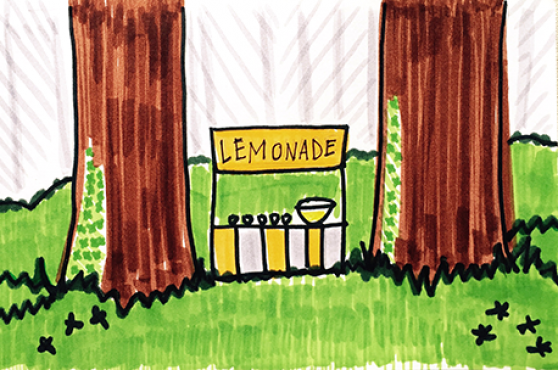(This is one of a series of posts we’re running on what inspires us as facilitators and designers here at Collective Next.)
On a recent beautiful, sunny Tuesday, my two children and I spent an afternoon in the park just up the hill from our home. We set out our picnic blanket on a green meadow in a glade of redwoods. The kids gleefully climbed up into the base of a cluster of ancient trees and jumped out, over and again, and played hide and seek among the ferns. They collected small natural treasures: bit of fungus, seed pods, stones.
Before long, a troop of 16 preschoolers wandered up the path to the meadow, their three grown-ups lugging heavy, oversized wooden objects at the head and the tail of the line. The group peacefully settled in next to us. The children sat around one of the teachers, who told a story about an owl. The other two adults, with the help of a few of the children, assembled the large wooden structure, which turned out to be a lemonade stand.
Soon everyone, including my children, joined in setting up the lemonade stand. They wiped down the board that would be their table. They filled a bowl with water and sliced and squeezed dozens of lemons. When it was all set, they beamed and poured watery lemon juice into tiny ceramic saké cups. At last, they sampled their product and exclaimed, “Yummmm!”
Then one of the children said, “Let’s bring these to the people!” They looked around the meadow, where ten or so small groups of sun revelers had appeared. The teachers agreed to this plan. Parties of three or four children set out to greet each group on the meadow, bearing saké cups with lemonade. I watched as the people of the meadow woke to the presence of the cheerful children and their gracious gifts, then accepted the cups, grinning with gratitude.
As a mom and as a designer of collaborative experiences, I was intrigued and inspired as I watched this scene. Whose idea was this lemonade stand? It looked heavy. It wasn’t easy for the adults to schlep it through the forest. Fifty ceramic saké cups – also no small feat. They set up a makeshift sink for washing out the cups and bowl before re-packing. Who thought to pack the soap?
More important: How did they know all that would be worth it? The complexity of what the children were able to glean from the experience – everything from how to pour the contents of a large bowl into a tiny cup to the social nuances of approaching strangers – was matched by the utter simplicity of design: Set up a kitchen in the forest and see what happens.
If your only job – as it should be when you’re a preschooler – is to learn, play, and grow, then a day in the forest is going to deliver no matter what. What happens when we grow up and get jobs? Learn, play, grow gets replaced by develop, measure, present, design, and iterate. What conditions – physical, psychological, social – let us do our best work? What is our forest, our meadow, our lemonade?
At Collective Next, we strive to find this perfect balance between complexity and simplicity. We deliver exceptionally elegant experiences in our design workshops and visual communications, though the underlying objectives and constraints can be extremely nuanced and complex.
People walk into our event spaces and they describe sensing, almost immediately, that something is very different. There is space and time for thoughtful and necessary conversations. Information is conveyed succinctly. Ideas are captured and published visually, in real time, as they surface.
It looks easy and effortless. It is neither. But our goals are as true as the forest kindergarten’s: Make room for learning, meaningful dialogue, shared understanding, and rich possibilities.
Back





